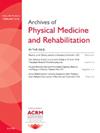针对脊髓损伤患者的社区锻炼计划的有效性:随机对照试验。
IF 3.6
2区 医学
Q1 REHABILITATION
Archives of physical medicine and rehabilitation
Pub Date : 2025-04-01
DOI:10.1016/j.apmr.2024.11.003
引用次数: 0
摘要
目的评估以社区为基础的结构化锻炼计划与常规护理相比,在增强脊髓损伤(SCI)患者的身体、功能和心理状况方面的效果:随机对照试验,比较运动组与常规护理组:地点:一所大学附属康复医院:57名能行走10米以上的慢性SCI患者:干预措施:对运动组进行为期 8 周、共 20 节课的指导,重点是柔韧性、有氧运动和强化训练,而常规护理组则保持常规的日常运动习惯:主要结果:主要结果包括6分钟步行测试,次要结果包括EuroQol-5 Dimensions 5-Level、脊髓独立性量表III、Berg平衡量表(BBS)、定时起立、握力、30秒坐立(30-STS)测试、坐立伸展测试(SRT)、贝克焦虑量表、贝克抑郁量表和生物电阻抗分析:51 名参与者被分配到干预组(36 人)和常规护理组(15 人),其中男性 34 人,女性 17 人(平均年龄为 59.78±13.19 岁)。其中颈椎病患者 24 人,胸椎病患者 17 人,腰椎病患者 8 人,骶椎病患者 2 人,所有患者均为运动性不完全性损伤。与常规护理组相比,运动组在以下方面有明显改善:6 分钟步行测试 49.80 米(95% CI:13.04,86.55),BBS 评分 3.50(95% CI:0.96,6.03),30-STS 2.38(95% CI:0.29,4.47),SRT 3.89 厘米(95% CI:0.96,6.82)。坚持率高达 89.6%,这表明社区锻炼计划对这一人群是可行的。然而,在心理和生活质量方面没有观察到明显的变化:以社区为基础的结构化锻炼计划在提高行走能力、平衡能力、下肢力量和柔韧性方面,对行动不便的 SCI 患者是可行且有效的。本文章由计算机程序翻译,如有差异,请以英文原文为准。
Effectiveness of a Community-Based Exercise Program for Ambulatory Individuals With Spinal Cord Injury: A Randomized Controlled Trial
Objective
To evaluate the effectiveness of a community-based structured exercise program, compared with usual care, in enhancing physical, functional, and psychological outcomes for ambulatory individuals with spinal cord injury (SCI).
Design
Randomized controlled trial comparing exercise group with usual care group.
Setting
One university-affiliated rehabilitation hospital.
Participants
Fifty-seven participants with chronic SCI who could walk more than 10 m.
Interventions
A supervised 20-session program focusing on flexibility, aerobic, and strengthening exercises was provided over 8 weeks for the exercise group, whereas the usual care group maintained their regular daily exercise routines.
Main Outcome Measures
Primary outcome included 6-minute walk test, and secondary outcomes assessed EuroQol-5 Dimensions 5-Level, Spinal Cord Independence Measure III, Berg Balance Scale, Timed Up and Go, grip strength, 30-second sit-to-stand test, sit and reach test, Beck Anxiety Inventory, Beck Depression Inventory, and bioelectrical impedance analysis.
Results
The 51 participants were allocated to intervention (n=36) and usual care (n=15) groups, consisting of 34 males and 17 females (average age, 59.78±13.19y). The participants included 24 with cervical, 17 with thoracic, 8 with lumbar, and 2 with sacral lesions, with all participants having motor incomplete injuries. The exercise group showed significant improvement compared with the usual care group in the 6-minute walk test by 49.80 m (95% confidence interval [CI], 13.04-86.55), Berg Balance Scale scores by 3.50 (95% CI, 0.96-6.03), 30-second sit-to-stand by 2.38 (95% CI, 0.29-4.47), and sit and reach test by 3.89 cm (95% CI, 0.96-6.82). The adherence rate was remarkably high at 89.6%, suggesting the feasibility of community exercise programs for this population. However, no significant changes were observed in psychological and quality-of-life measures.
Conclusions
Community-based structured exercise programs have been shown to be both feasible and effective in improving walking capacity, balance, lower extremity strength, and flexibility in ambulatory individuals with SCI.
求助全文
通过发布文献求助,成功后即可免费获取论文全文。
去求助
来源期刊
CiteScore
6.20
自引率
4.70%
发文量
495
审稿时长
38 days
期刊介绍:
The Archives of Physical Medicine and Rehabilitation publishes original, peer-reviewed research and clinical reports on important trends and developments in physical medicine and rehabilitation and related fields. This international journal brings researchers and clinicians authoritative information on the therapeutic utilization of physical, behavioral and pharmaceutical agents in providing comprehensive care for individuals with chronic illness and disabilities.
Archives began publication in 1920, publishes monthly, and is the official journal of the American Congress of Rehabilitation Medicine. Its papers are cited more often than any other rehabilitation journal.

 求助内容:
求助内容: 应助结果提醒方式:
应助结果提醒方式:


